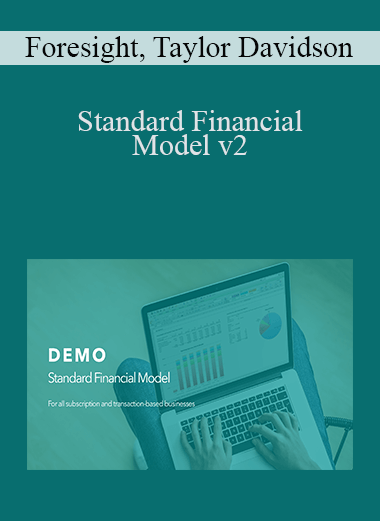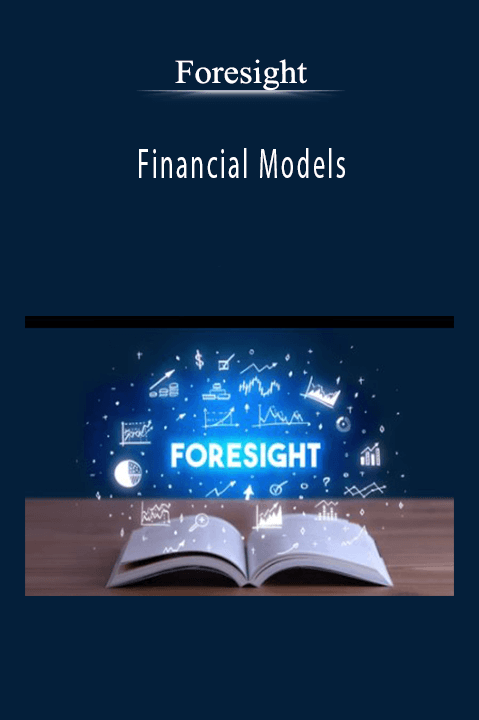Original price was: $150.00.$40.00Current price is: $40.00.
Digital Download: Foresight, Taylor Davidson – Standard Financial Model v2
You will have access to the digital downloads in your order email.
You will also be able to access your downloads from your account dashboard.
Short Description:
Best for building comprehensive financial and operational forecasts for businesses with a mixture of SaaS (B2C and SMB B2B), ecommerce, subscription, marketplace, and/or advertising revenue models, complete with financial statements, funding needs, cap table, and valuation…
Description
Standard Financial Model v2
Best for building comprehensive financial and operational forecasts for businesses with a mixture of SaaS (B2C and SMB B2B), ecommerce, subscription, marketplace, and/or advertising revenue models, complete with financial statements, funding needs, cap table, and valuation. Instant download, use in Microsoft Excel™, Google Docs™, and other spreadsheet programs.
- Are you starting a business or have an ongoing business and need to forecast your operations and financials? Do you need to understand your costs, revenues and key metrics better for your own business planning or to present to investors? Build a complete set of financial projections for your business in hours using the Standard Financial Model v2. The Standard Model is the base for building a model for any type of business.
- The model is built to give you all the structure you need to build operational and financial forecasts for your business, whether your revenue model is based on subscriptions, transactions, or advertising – SaaS, ecommerce, marketplaces, apps, advertising, hardware, software, and more (note: if you have a simple business model and want to build a model faster, use the Starter Financial Model). The forecast is done monthly, quarterly and annually over a 5 year period. And, it can all be modified to add in your own unique revenue calculations, as all formulas and cells are completely open and unlocked. Purchase one-time, customize however and whenever you want, and updates to the model are automatically distributed for free.
- All businesses, startups to growth-stage, tech and non-tech.
- Works for companies starting from scratch as well as companies with multiple years of historical operational and financial data that they want to use in reporting and forecasting.
- Create anything from a simple 12 month cost budget up to a detailed, 6+ year forecast of users, revenues, financial statements, valuation, capitalization, and exit.
- Works for multiple types of business models, but can also be adapated to your specific business needs.
- Subscription-based businesses (SaaS, enterprise SaaS, B2C SaaS, subscription commerce, content subscriptions, etc.)
- Transaction-based businesses, including direct retailers, apps, for one-time or recurring transactions.
- Marketplaces, including marketplaces like Etsy and services marketplaces like Uber.
- Combinations of the above, including hardware companies with software subscriptions (Fitbit and others), subscription services with ecommerce add-ons (Harry’s, Amazon Prime, and more), companies with free advertising-supported freemium levels alongside paid subsciptions and potentially additional transactions, etc.
Advertising-based businesses like website publishers selling ads directly or through ad exchanges.
- I created the financial models behind Foresight so early-stage entrepreneurs can spend less time on finance and more time on their products. I’ve been building and helping entrepreneurs build financial models for startups since 1998
- The completely redone v2 features a brand new architecture for forecasting your costs and hiring plan in a simpler yet more powerful way than before, to create a cost budget simpler and faster.
- Assumptions are structured on one page, with the option to alter them on individual time periods on each calculation sheet.
- User acquisition is broken out by channels, sources and mediums, and can be mapped to your Google Analytics data.
- User retention is modeled by cohorts, subscriptions, and straight manual inputs if desired.
- Revenue forecasts for subscription, SaaS, ecommerce, marketplaces, advertising, and app-based businesses.
- Full financial statements, metrics and charts already built in.
- Cashflow analysis, including external funding forecasts, is integrated into the model with a capitalization table, forecasting out investment rounds, dilution and ownership (optional).
- Valuation is aided with built-in structures for discounted cash flow, VC Method, and market comparables valuation methodologies.
- All formulas and sheets are open for editing, anything is open for editing. I don’t believe that models should be locked, everything should be open for you to edit so that you can model your business exactly as you want.
- 1. README. Description of model, layout, and how to use it.
- 2. Outline, How To – Model, and How To – Assumptions. Three sheets that detail the model and how calculations flow, explaining how each sheet works and explaining each assumption.
- 3. Key Reports. Charts and tables of costs, active users (optional), cash on hand, revenue and revenue growth rate, net income and cumulative net income, margins, sources and uses, and more.
- 4. Summary. Key operational and financial metrics organized in a clean summary, reported over twelve months and 3 years, built to be easily customizable for your key metrics and timeframes.
- 5. Assumptions. Over 200 potential assumptions to use.
- 6. Users and Revenues. Key user and customer calculations by monthly cohorts, subscriptions, or manual inputs, and revenue calculations for each available (and optional) revenue model.
- 7. Statements. Consolidated financial statements, including income statement, balance sheet, and statement of cash flows. Use this only for forecasting or bring in your historical financials to show either a mix of the past and the future, or to compare budgets to forecasts.
- 9. Cap Table. The cap table in the Standard Model v2 is the Cap Table Model integrated into the cash flows of the business, mapping forecasted expenses and net burn to needed fundraising to estimated funding rounds by size and date.
- 10. Valution. Starting points for discounted cash flow, market multiples and VC Method valuations.
- 11. Changelog. Details of all edits to the model since release, by version number.
- The model includes over 200 assumptions around user acquisition, retention and activity, revenues, costs, funding, and valuation. For a detailed explanation of all the assumptions. But as an overview, the key inputs include, but are not limited to:
- Acquisition: User, customer or transaction acquisition by paid acquisition channels (Facebook, Google, etc.), content and SEO, partnerships, and business development
- Retention: User retention and activity with your business, for subscription and non-subscription businesses
- Revenues: many assumptions are optional, as you only need to use the ones for your type of business. Subscription and SaaS inputs include prices, contract lengths (any time period), one-time fees, COGS per subscription, seats per customers (for enterprise or SMB SaaS), and more. Ecommerce and transaction inputs include orders, repeat orders, and the products in an order, by prices, items per order, COGS, discounts, and more. Marketplaces include everything to calculate gross transaction value as well as marketplace take rate and seller forecasting, including new sellers, repeat sellers, liquidity, and more.
- Hiring: staff hiring, salaries, roles, and when to hire, including flexible team-based hiring assumptions to calculate team sizes automatically based on company growth.
- Costs: flexible inputs to calculate all costs based on per month, per employee, % of revenue, quarterly, annually, and more forecasting methods. Expenses can be allocated to SG&A;, COGS, or CAPEX.
- Funding: equity fundraising forecasting, number of months to raise capital, % of the company sold in investment round (premoney valuation).
- Valuation: methods for discounted cash flow, multiples, and VC Method valuations.
Digital Download Foresight, Taylor Davidson – Standard Financial Model v2 at imgcap.top Now!
Sales page:
Archive: https://web.archive.org/web/20170515034942/https://foresight.is/standard-financial-model


8 reviews for Foresight, Taylor Davidson – Standard Financial Model v2
There are no reviews yet.